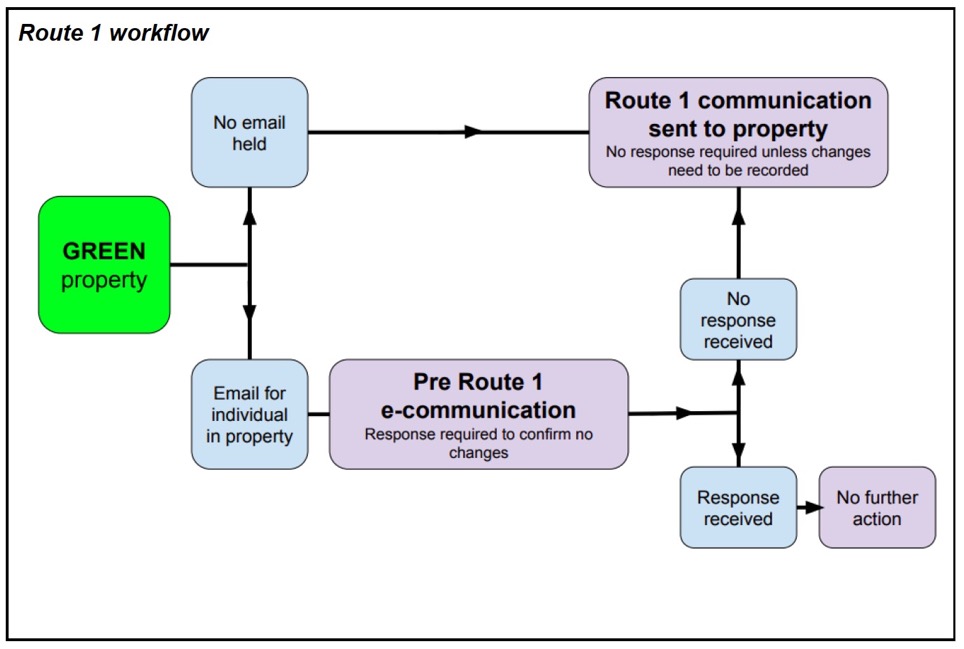Annual canvass reform proposals: consultation paper
This policy statement sets out the revised model for the annual canvass which has been drawn up by the UK, Scottish and Welsh Government, and seeks views from all interested parties.
Section 5 - Route 1: the lighter touch route
Under the current canvass process EROs must send every residential property in their area a Household Enquiry Form ( HEF) and are required to follow up non-responses with two reminders and, if necessary, a household visit. Whilst the majority of households do not need to report a change in household composition, the ERO needs a response from every household.
A key feature of the proposed model for canvass reform is that, where the ERO can ‘match’ all electors at the property using nationally and locally held data, they will be directed down Route 1. Green match households should have no change in composition and therefore there will be no need to inform the ERO of any major changes [10] (i.e. elector addition or deletion). In such a situation, it is unnecessary and wasteful for the ERO to have to use resource in chasing up responses in these circumstances.
We propose that green match households will be sent a simple communication setting out everyone who is registered at the address. We consider that it is important that even green match households are contacted by their ERO at least once during the canvass, to provide an opportunity for the household to let the ERO know if anything has changed. A crucial difference from the current canvass process is that if no response is received from these properties the ERO will have the option to not follow up for a response.
This initial communication should generally be by paper - which will ensure that the occupiers of a property receive the correspondence in order to amend details if required. Given that there will be no requirement to respond if there is no change, it will be important that the ERO is confident that the current occupiers of the property receives this communication.
However, we also acknowledge the desire of both administrators and citizens to move to a more digital-enabled process and thus propose to allow an e-communication [11] for this stage of the process. During the canvass pilots, email communication was trialled and, whilst many benefits were realised, some risks were identified. For example, there is no clear connection between a property and an email address. Given this, we are proposing that e-communications can be used but will require specific confirmation from the elector that their details are still correct to act as a safeguard. This is expected to be a simple one click process. If the elector fails to respond to an e-communication then the property will be sent a paper communication to ensure the occupants receive the information.
It is most likely that EROs will use email in this pre-paper e-communication, although future developments will be allowed for, such as a notification through a Council account. The email will be sent to any elector, over 18, in the property who the ERO holds an email address for. The use of email will be subject to data protection requirements to ensure the appropriate security of electors’ information. Given the low cost of sending emails and that any non-responders would still receive a paper contact sent to the address, there are clear advantages to a pre-paper e-communication stage. This option will only be available where an ERO believes there is no change in the composition of the household, so email addresses for current electors should still be correct. In addition, responses to the email will reduce the number of unnecessary paper contacts which will need to be sent; a further cost saving.

We invite responses to the following questions relating specifically to the proposed processes detailed in Section 5: Route 1: the lighter touch route
Question 7
Do you agree that an email contact should be permitted as the first form of contact for households in Route 1 (where an email address is held), followed by a paper contact if there is no response? YES/NO
If No, please explain your reasoning.
Question 8
Do you agree with the proposed process for the Route 1? YES/NO
Please explain why.
Question 9
Do you agree with the proposal to exclude mandatory follow up activity (reminders and household visits, etc.) with households sent through Route 1? YES/NO
Please explain why.
Contact
There is a problem
Thanks for your feedback